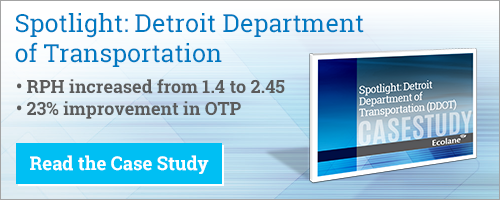You’ve heard the story before, or maybe you’ve even experienced it firsthand: a transit agency invests a lot of time, money, and additional resources into their paratransit software only to find that their operations are still experiencing inefficiencies and roadblocks.
Transit agencies adopt software systems to help solve operational inefficiencies and overcome roadblocks, not cause them.
So what truly defines the difference between software systems that work and those that don’t? We’re outlining some of the key factors that differentiate software systems and can take them from mediocre to transformational.
What Makes Demand Response Software Work for Paratransit?
-
Visibility
Without the ability to get a big-picture, 360-degree view of your operations with real-time dashboard screens and access data analytics on-demand, what’s the point of having paratransit software? Systems that work help agencies solve efficiency challenges, offering features that give management greater visibility into important aspects of daily operations. These features include: real-time and on-time performance visibility; insight into driver errors which may cause late or missed trips; algorithms that adjust on the fly to prevent late and missed trips from happening in the first place; and robust, one-click reporting for anytime, anyplace mobile access of real-time data. Decision makers can run reports and begin identifying patterns to get to the root of an underlying issue. This allows transit agencies to make strategic changes to improve operations based on analytics. -
Automation
There’s nothing that causes more inefficiency or costly errors than a lack of automation in the software. The more you run important tasks like scheduling or dispatching through manual processes, the greater chance you’ll encounter human errors that will lead to drivers running behind schedule, increased costs, lower customer service and disjointed communication. With automation, you’ll free up key resources within your agency and eliminate major bottlenecks. You’ll begin to see an improvement in on-time performance and rides per hour, both scheduled and delivered, and you’ll drive down costs by reducing fuel costs and overtime hours. -
Flexibility
A software system is not one-size-fits-all. With cookie-cutter systems, you aren’t able to adapt the software to meet the needs of your operations. Instead of trying to fit a square peg into a round hole, find a system that allows your agency flexibility. During the implementation process, you can find ways to set up the software to match the way your agency actually operates instead of having to try and match your operations to the limited capabilities of the software. Additionally, you’ll want a solution that allows flexibility in day-to-day tasks, such as adjusting trip manifests.
Overall, paratransit software that works brings greater overall efficiency to a transit or PACE agency. If a system doesn’t provide greater visibility, trip scheduling automation, and allow for flexibility (both during implementation and in day-to-day operations), then it simply will cause more roadblocks and operational inefficiencies for a transit agency.
The Detroit Department of Transportation (DDOT) experienced firsthand how implementing a modern demand response software system dramatically improved operations and efficiency through multi-level optimization and software automation. To find out more about the specific roadblocks that they faced and how they were able to overcome them with the implementation of Ecolane’s software solution, download the case study.
About the Author

Ecolane
Read Ecolane's blog articles for perspective, opinion and information on transit and paratransit issues.
%20(200%20x%20100%20px).png)

